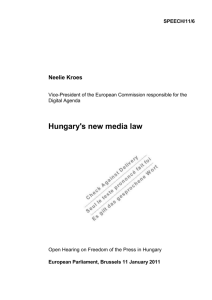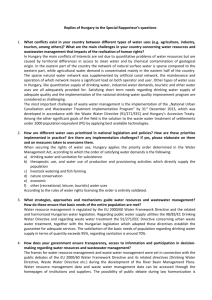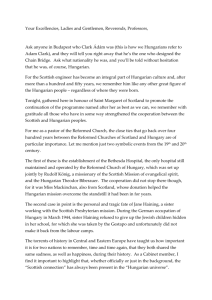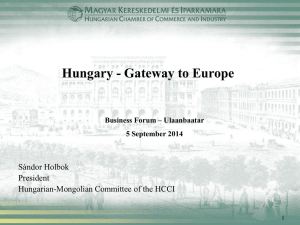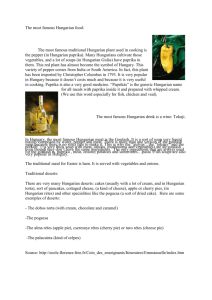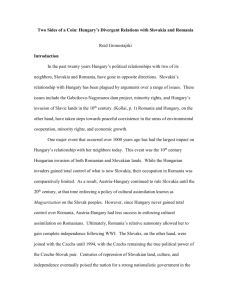Gazetteers & Research In The Kingdom Of Hungary
advertisement
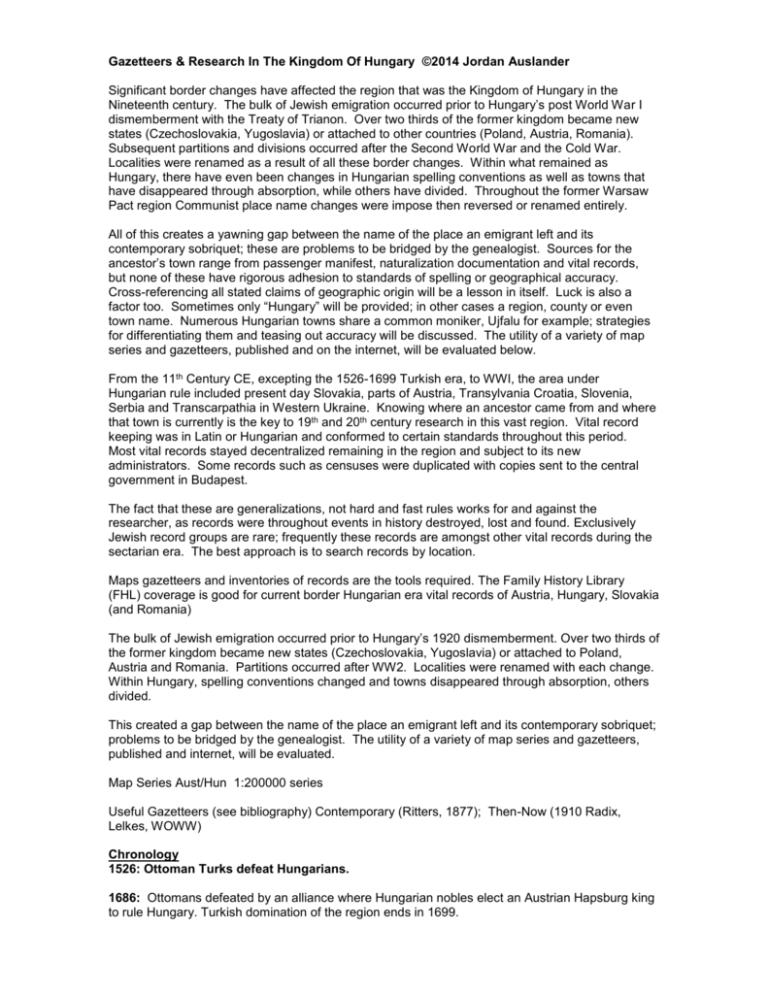
Gazetteers & Research In The Kingdom Of Hungary ©2014 Jordan Auslander Significant border changes have affected the region that was the Kingdom of Hungary in the Nineteenth century. The bulk of Jewish emigration occurred prior to Hungary’s post World War I dismemberment with the Treaty of Trianon. Over two thirds of the former kingdom became new states (Czechoslovakia, Yugoslavia) or attached to other countries (Poland, Austria, Romania). Subsequent partitions and divisions occurred after the Second World War and the Cold War. Localities were renamed as a result of all these border changes. Within what remained as Hungary, there have even been changes in Hungarian spelling conventions as well as towns that have disappeared through absorption, while others have divided. Throughout the former Warsaw Pact region Communist place name changes were impose then reversed or renamed entirely. All of this creates a yawning gap between the name of the place an emigrant left and its contemporary sobriquet; these are problems to be bridged by the genealogist. Sources for the ancestor’s town range from passenger manifest, naturalization documentation and vital records, but none of these have rigorous adhesion to standards of spelling or geographical accuracy. Cross-referencing all stated claims of geographic origin will be a lesson in itself. Luck is also a factor too. Sometimes only “Hungary” will be provided; in other cases a region, county or even town name. Numerous Hungarian towns share a common moniker, Ujfalu for example; strategies for differentiating them and teasing out accuracy will be discussed. The utility of a variety of map series and gazetteers, published and on the internet, will be evaluated below. From the 11th Century CE, excepting the 1526-1699 Turkish era, to WWI, the area under Hungarian rule included present day Slovakia, parts of Austria, Transylvania Croatia, Slovenia, Serbia and Transcarpathia in Western Ukraine. Knowing where an ancestor came from and where that town is currently is the key to 19th and 20th century research in this vast region. Vital record keeping was in Latin or Hungarian and conformed to certain standards throughout this period. Most vital records stayed decentralized remaining in the region and subject to its new administrators. Some records such as censuses were duplicated with copies sent to the central government in Budapest. The fact that these are generalizations, not hard and fast rules works for and against the researcher, as records were throughout events in history destroyed, lost and found. Exclusively Jewish record groups are rare; frequently these records are amongst other vital records during the sectarian era. The best approach is to search records by location. Maps gazetteers and inventories of records are the tools required. The Family History Library (FHL) coverage is good for current border Hungarian era vital records of Austria, Hungary, Slovakia (and Romania) The bulk of Jewish emigration occurred prior to Hungary’s 1920 dismemberment. Over two thirds of the former kingdom became new states (Czechoslovakia, Yugoslavia) or attached to Poland, Austria and Romania. Partitions occurred after WW2. Localities were renamed with each change. Within Hungary, spelling conventions changed and towns disappeared through absorption, others divided. This created a gap between the name of the place an emigrant left and its contemporary sobriquet; problems to be bridged by the genealogist. The utility of a variety of map series and gazetteers, published and internet, will be evaluated. Map Series Aust/Hun 1:200000 series Useful Gazetteers (see bibliography) Contemporary (Ritters, 1877); Then-Now (1910 Radix, Lelkes, WOWW) Chronology 1526: Ottoman Turks defeat Hungarians. 1686: Ottomans defeated by an alliance where Hungarian nobles elect an Austrian Hapsburg king to rule Hungary. Turkish domination of the region ends in 1699. 1690s: To consolidate their power base, Austrians and landed Hungarians encourage non-Magyar influx, including Slovaks and Jews to resettle the war-torn land. Hapsburgs dominating the Empire promote use of German language. The Historic Lands, Bohemia, Moravia and Silesia, come under Austrian rule; Slovakia and Subcarpathian Ruthenia, within Hungary's realm. 1772: Galicia annexed 1774: Bukowina annexed by Austria. 1867: Hungarian Diet passes Emancipation Act granting Jews full citizenship, residence restrictions and serfdom abolished. Place names changed to Hungarian. 1918; October 28: Czechoslovakia created, a union of Bohemia, Moravia, Slovakia and Subcarpathian Ruthenia; formalized, in a triumph of pan Slavic hopes, with the 1920 treaty of Trianon which dismantled the Austro-Hungarian Empire. Place names changed to Slovak. 1945: Transcarpathia ceded to USSR 1989-93: Fall of USSR Velvet Revolution etc. Many Communist name changes reversed To search Slovakian resources available through The FHL: http://www.familysearch.org/Eng/Library/fhlcatalog/supermainframeset.asp To search the FHL catalog by alphabetically by locality (grouped numerically) http://www.familysearch.org/Eng/Library/fhlcatalog/supermainframeset.asp?fir= st=3D1&display=3Dlocalityrelated&subject=3D90&subject_disp=3DSlovakia&last=3D Then add the number range of towns to search, there are many. Radix: Cross-referenced place & surname index, databases1913 Gazetteer, military maps on-line (by subscription) http://www.radixindex.com/ Misc. Memorial Museum of Hungarian Speaking Jewry P.O.B. 1168, Kikar Haazmaut, Safed, 13111, ISRAEL. Tel/Fax: +972-4-6923880, +972-4-6925881 Opening hours: Sun-Fri: 9:00-13:00 English: http://www.hjm.org.il/ GAZETTEERS & MAPS Auslander, Jordan, Genealogical Gazetteer for the Kingdom of Hungary, Avotaynu, Bergenfield NJ 2005 Dvorzsák, János Magyarország helységnévtára tekintettel a közigazgatási, népességi és hitfelekezeti viszonyokra (Locality dictionary of Hungary with reference to the political and ecclesiastical classifications of the population) Budapest, 1877. Eckschmidt, Kata; Szilvia Eckschmidt, Andrea Fodor, Zsuzsa Gebry, Zsolt Kovát and József Sziládi, Zsolt Kárpátalja térképe, Budapest, Hungary, Dimap Bt. 2000, 2003. Multi-lingual 1:250,000 map and gazetteer of Subcarpathian region. Dimap (www.dimap.hu) has excellent maps for East and Central European regions as well. Henne-AmRhyn, Dr. Otto, Ritter's Geographisch Statistisches Lexikon, Verlag von Otto Wigand, Leipzig, Germany, 1874. Comprehensive gazetter of the world’s cities and towns c. 1874; reprinted 1983 ISBN 3922-693-008 Lelkes, György, Magyar Helysegnev-Azonosito Szotar, Talma Könyvkaidó, Baja, Hungary, 1992 &1998 eds. The most comprehensive listing of present and former Hungarian towns with county and district, not most settlements, their current name and country. County level maps but without contemporary borders Maijtán, Milan, Nazvy obci Slovenskej Republiky (Vyvin v rokoch 1773–1997). Bratislava, Slovakia, Slovenskej akademie vied, 1998.Includes place names of Slovakia in the last 200 years, including Hungarian and German names. The main difference between the two (1972 & 1998) editions is that the 1998 edition follows the 1996 official realignment of districts (okres) and regions (kraj) of the Slovak Republic. Each town is listed in its current district and region along with any mergers or separations that occurred over the past 200 years. Mokotoff, Gary and Sallyann Amdur Sack with Alexander Sharon. Where Once We Walked: Revised Edition. Bergenfield, N.J.: Avotaynu, 2002. Present and former names of Central and Eastern European towns with pre-WWII Jewish populations of 10 or more. Putman, John J., Hungary’s New Way, National Geographic, Vol 163, no. 2, February 1983, p225 Cirkevné Matriky Na Slovensku Zo 16.–19. Storocia, Parish Registers in Slovakia From the 16th to 19th Century, Jana Saramanyova, Odbor Archivnictva Ministerstva Vnutra SR, Bratislava, 1991 Sebók, László, Magyar Neve? - Hatarokon tuli magyar helysegnevszotar, Hungary, Arany Lapok 1990. Lists current and past Hungarian Kinghom localities that included parts (or all) of Austria, Yugoslavia, Ukraine, Poland, Slovakia, and Romania. Place names for these countries are alphabetized as well as their Hungarian equivalent. Sebók, László, Határokon Túli Magyar Helységnévszótár, Budapest, Hungary 1997. Lists current names for towns previously in the Kingdom of Hungary, breakdowns of localities by contemporary country. Spezialkarte der Österrreichisch-Ungarishen Monarchie, K.uK. Militärigeographisches Institut. Vienna, 1877–1914. Austro-Hungarian 1:75000 map series available at the New York Public Library’s Map Division (call#04-336) and on-line now on NYPL’s website U.S. Board on Geographical Names (BGN) # 52 Hungary, Office of Geography, Washington DC, May 1961. Definitive listing of contemporary Hungarian place names. Zentai, Dr László editor, Kósa, Pál, et al; A Történelmi Magyaroszág Atlasza és Adattára 1914, Talma Kaidó, Pécs 2001. Old and new name gazetteer, demographic and statistical 1910 census data for the Kingdom of Hungary at its zenith; 1:200,000 sectional maps of 1914 Hungary but no current frame of reference. "Historical Maps of the Hapsburg Empire" or MAPIRE at: http://mapire.staatsarchiv.at/en/

![View full document [DOC 121.00 KB]](http://s3.studylib.net/store/data/007311467_1-d846f7b116a73f74023d7a29ba436503-300x300.png)
